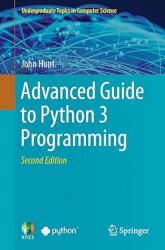Advanced Guide to Python 3 Programming, 2nd Edition
- Добавил: literator
- Дата: 3-10-2023, 08:36
- Комментариев: 0
 Название: Advanced Guide to Python 3 Programming, 2nd Edition
Название: Advanced Guide to Python 3 Programming, 2nd EditionАвтор: John Hunt
Издательство: Springer
Год: 2023
Страниц: 638
Язык: английский
Формат: pdf (true), epub
Размер: 46.0 MB
Advanced Guide to Python 3 Programming 2nd Edition delves deeply into a host of subjects that you need to understand if you are to develop sophisticated real-world programs. Each topic is preceded by an introduction followed by more advanced topics, along with numerous examples, that take you to an advanced level.
This second edition represents a significant expansion of the material in the first edition, as well as an update of that book from Python 3.7 to 3.12. This book includes whole new sections on advanced language features, Reactive Programming in Python and data analysts. New chapters on working with Tkinter, on event handling with Tkinter and a simple drawing application using Tkinter have been added. A new chapter on performance monitoring and profiling has also been added. A chapter on pip and conda is included at the end of the book. In all there are 18 completely new chapters that take you far further on your Python journey. The examples used in this book (along with sample solutions for the exercises at the end of most chapters) are available in a GitHub repository. GitHub provides a web interface to Git, as well as a server environment hosting Git.
I have heard many people over the years say that Python is an easy language to learn and that Python is also a simple language. To some extent both of these statements are true; but only to some extent. While the core of the Python language is easy to lean and relatively simple (in part thanks to its consistency), the sheer richness of the language constructs and flexibility available can be overwhelming. In addition the Python environment, its eco system, the range of libraries available, the often competing options available, etc., can make moving to the next-level daunting. Once you have learned the core elements of the language such as how classes and inheritance work, how functions work, what are protocols and Abstract Base Classes, etc. where do you go next?
The aim of this book is to delve into those next steps. The book is organised into eleven different topics:
• 1. Advanced Language Features. The first section in the book covers topics that are often missed out from introductory Python books such as slots, weak references __init__() versus __new__() and metaclasses.
• 2. Computer Graphics. The book covers Computer Graphics and Computer Generated Art in Python as well as graphical user interfaces and graphing/charting via Matplotlib.
• 3. Games Programming. This topic is covered using the pygame library.
• 4. Testing and Mocking. Testing is an important aspect of any software development; this book introduces testing in general and the PyTest module in detail. It also considers mocking within testing including what and when to mock.
• 5. File Input/Output. The book covers text file reading and writing as well as reading and writing CSV and Excel files. Although not strictly related to file input, regulator expressions are included in this section as they can be used to process textual data held in files.
• 6. Database Access. The book introduces databases and relational database in particular. It then presents the Python DB-API database access standard and one implementation of this standard, the PyMySQL module used to access a MySQL database.
• 7. Logging. An often missed topic is that of logging. The book therefore introduces logging the need for logging, what to log and what not to log as well as the Python logging module.
• 8. Concurrency and Parallelism. The book provides extensive coverage of concurrency topics including threads, processes and inter-thread or process synchronisation. It also presents futures and AsyncIO.
• 9. Reactive Programming. This section of the book introduces Reactive Programming using the PyRx Reactive Programming library.
• 10. Network Programming. The book introduces socket and web service communications in Python. It looks at both the Flask and the Django web service libraries.
• 11. Data Analytics. A very hot topic for any potential Python programmer is data analytics (and the related use of machine learning). The book concludes by introducing these topics and there Pandas and Scikit-learn (or SK-learn as it is sometimes known) libraries.
Скачать Advanced Guide to Python 3 Programming, 2nd Edition
[related-news] [/related-news]
Внимание
Уважаемый посетитель, Вы зашли на сайт как незарегистрированный пользователь.
Мы рекомендуем Вам зарегистрироваться либо войти на сайт под своим именем.
Уважаемый посетитель, Вы зашли на сайт как незарегистрированный пользователь.
Мы рекомендуем Вам зарегистрироваться либо войти на сайт под своим именем.
